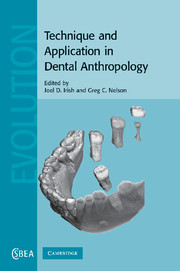Book contents
- Frontmatter
- Contents
- Contributors
- Acknowledgments
- Section I Context
- Section II Applications in assessing population health
- Section III Applied life and population history
- 9 Charting the chronology of developing dentitions
- 10 Dental age revisited
- 11 Primate dental topographic analysis and functional morphology
- 12 Forensic dental anthropology: issues and guidelines
- 13 Inter- and intra-specific variation in Pan tooth crown morphology: implications for Neandertal taxonomy
- 14 The quantitative genetic analysis of primate dental variation: history of the approach and prospects for the future
- Section IV Forefront of technique
- Index
- References
10 - Dental age revisited
Published online by Cambridge University Press: 12 September 2009
- Frontmatter
- Contents
- Contributors
- Acknowledgments
- Section I Context
- Section II Applications in assessing population health
- Section III Applied life and population history
- 9 Charting the chronology of developing dentitions
- 10 Dental age revisited
- 11 Primate dental topographic analysis and functional morphology
- 12 Forensic dental anthropology: issues and guidelines
- 13 Inter- and intra-specific variation in Pan tooth crown morphology: implications for Neandertal taxonomy
- 14 The quantitative genetic analysis of primate dental variation: history of the approach and prospects for the future
- Section IV Forefront of technique
- Index
- References
Summary
Introduction
Tooth formation spans childhood, with hard tissue formation beginning during the first trimester in utero, continuing during infancy up to adulthood, and ends with maturation of the root apices of the third permanent molars. This long duration makes developing teeth a useful indicator of maturation in the clinical setting, and estimator of age of minors who lack official identification and/or seek asylum, forensic identification, and for immature skeletal remains obtained from archaeology contexts. Measuring tooth formation is complex and differs from other maturing body systems; as such, some knowledge of the difficulties and challenges of different methods is needed to estimate age. This chapter builds on work by Scheuer and Black (2000), and is divided into two sections: quantifying dental formation and estimating age. Each section includes definitions, descriptions of difficulties, how to measure growth and maturation of teeth and the dentition, how to estimate age from growth and maturation references, some comparison between methods, and finally, recommendations.
Quantifying dental formation
Definitions of dental growth and maturation
Although growth and maturation are intimately related, some definitions are needed to clarify the differences between these two processes and the techniques used to measure them. Two recent books review the principles and methodology of human growth and maturation (Cameron, 2002; Hauspie et al., 2004) and are highly recommended. Growth represents an increase in the size/volume, and once dentine and enamel begin to form, growth of a tooth can be quantified by measuring crown height, root length/volume, root cone angle, apex width, or other dimensions.
- Type
- Chapter
- Information
- Technique and Application in Dental Anthropology , pp. 234 - 252Publisher: Cambridge University PressPrint publication year: 2008
References
- 22
- Cited by

